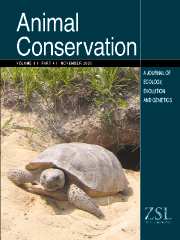Crossref Citations
This article has been cited by the following publications. This list is generated based on data provided by
Crossref.
Williams, Paul
and
Manne, Lisa
2001.
Encyclopedia of Biodiversity.
p.
192.
WILLIAMS, PAUL
HANNAH, LEE
ANDELMAN, SANDY
MIDGLEY, GUY
ARAÚJO, MIGUEL
HUGHES, GREG
MANNE, LISA
MARTINEZ‐MEYER, ENRIQUE
and
PEARSON, RICHARD
2005.
Planning for Climate Change: Identifying Minimum‐Dispersal Corridors for the Cape Proteaceae.
Conservation Biology,
Vol. 19,
Issue. 4,
p.
1063.
BHAGWAT, SHONIL A.
KUSHALAPPA, CHEPPUDIRA G.
WILLIAMS, PAUL H.
and
BROWN, NICK D.
2005.
A Landscape Approach to Biodiversity Conservation of Sacred Groves in the Western Ghats of India.
Conservation Biology,
Vol. 19,
Issue. 6,
p.
1853.
Sarkar, Sahotra
Pressey, Robert L.
Faith, Daniel P.
Margules, Christopher R.
Fuller, Trevon
Stoms, David M.
Moffett, Alexander
Wilson, Kerrie A.
Williams, Kristen J.
Williams, Paul H.
and
Andelman, Sandy
2006.
Biodiversity Conservation Planning Tools: Present Status and Challenges for the Future.
Annual Review of Environment and Resources,
Vol. 31,
Issue. 1,
p.
123.
Favreau, Jorie M.
Drew, C. Ashton
Hess, George R.
Rubino, Matthew J.
Koch, Frank H.
and
Eschelbach, Katherine A.
2006.
Recommendations for Assessing the Effectiveness of Surrogate Species Approaches.
Biodiversity & Conservation,
Vol. 15,
Issue. 12,
p.
3949.
Freemark, Kathryn E
Meyers, Mark
White, Denis
Warman, Leanna D
Kiester, A Ross
and
Lumban-Tobing, Pago
2006.
Species richness and biodiversity conservation priorities in British Columbia, Canada.
Canadian Journal of Zoology,
Vol. 84,
Issue. 1,
p.
20.
RONDININI, CARLO
and
BOITANI, LUIGI
2006.
Differences in the Umbrella Effects of African Amphibians and Mammals Based on Two Estimators of the Area of Occupancy.
Conservation Biology,
Vol. 20,
Issue. 1,
p.
170.
Williams, Paul
Faith, Dan
Manne, Lisa
Sechrest, Wes
and
Preston, Chris
2006.
Complementarity analysis: Mapping the performance of surrogates for biodiversity.
Biological Conservation,
Vol. 128,
Issue. 2,
p.
253.
Williams, Paul
and
Manne, Lisa
2007.
Encyclopedia of Biodiversity.
p.
1.
LARSEN, FRANK WUGT
BLADT, JESPER
and
RAHBEK, CARSTEN
2007.
Improving the Performance of Indicator Groups for the Identification of Important Areas for Species Conservation.
Conservation Biology,
Vol. 21,
Issue. 3,
p.
731.
Lawler, J. J.
and
White, D.
2008.
Assessing the mechanisms behind successful surrogates for biodiversity in conservation planning.
Animal Conservation,
Vol. 11,
Issue. 4,
p.
270.
Cabeza, Mar
Arponen, Anni
and
Van Teeffelen, Astrid
2008.
Top predators: hot or not? A call for systematic assessment of biodiversity surrogates.
Journal of Applied Ecology,
Vol. 45,
Issue. 3,
p.
976.
Bladt, J.
Larsen, F. W.
and
Rahbek, C.
2008.
Does taxonomic diversity in indicator groups influence their effectiveness in identifying priority areas for species conservation?.
Animal Conservation,
Vol. 11,
Issue. 6,
p.
546.
GROUIOS, CHRISTOPHER P.
and
MANNE, LISA L.
2009.
Utility of Measuring Abundance versus Consistent Occupancy in Predicting Biodiversity Persistence.
Conservation Biology,
Vol. 23,
Issue. 5,
p.
1260.
Larsen, Frank Wugt
Bladt, Jesper
and
Rahbek, Carsten
2009.
Indicator taxa revisited: useful for conservation planning?.
Diversity and Distributions,
Vol. 15,
Issue. 1,
p.
70.
Halme, Panu
Kotiaho, Janne S.
Ylisirniö, Anna-Liisa
Hottola, Jenni
Junninen, Kaisa
Kouki, Jari
Lindgren, Mariko
Mönkkönen, Mikko
Penttilä, Reijo
Renvall, Pertti
Siitonen, Juha
and
Similä, Maarit
2009.
Perennial polypores as indicators of annual and red-listed polypores.
Ecological Indicators,
Vol. 9,
Issue. 2,
p.
256.
Pfeifer, Marion
Passalacqua, Nicodemo G.
Bartram, Stefan
Schatz, Bertrand
Croce, Antonio
Carey, Pete D.
Kraudelt, Heide
and
Jeltsch, Florian
2010.
Conservation priorities differ at opposing species borders of a European orchid.
Biological Conservation,
Vol. 143,
Issue. 9,
p.
2207.
Grantham, Hedley S.
Pressey, Robert L.
Wells, Jessie A.
Beattie, Andrew J.
and
Moen, Jon
2010.
Effectiveness of Biodiversity Surrogates for Conservation Planning: Different Measures of Effectiveness Generate a Kaleidoscope of Variation.
PLoS ONE,
Vol. 5,
Issue. 7,
p.
e11430.
de Thoisy, Benoît
Richard-Hansen, Cécile
Goguillon, Bertrand
Joubert, Pierre
Obstancias, Jean
Winterton, Peter
and
Brosse, Sébastien
2010.
Rapid evaluation of threats to biodiversity: human footprint score and large vertebrate species responses in French Guiana.
Biodiversity and Conservation,
Vol. 19,
Issue. 6,
p.
1567.
Ortega-Baes, Pablo
Sühring, Silvia
Sajama, Jesús
Sotola, Ezequiel
Alonso-Pedano, Mariana
Bravo, Silvia
and
Godínez-Alvarez, Héctor
2010.
Desert Plants.
p.
157.


